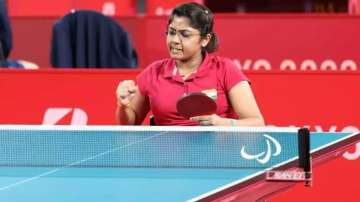Food or no food, sleep or no sleep but table tennis at all times: Bhavina Patel's mantra to Paralympics
Diagnosed with polio when she was 12 months old, the 34-year-old is now scripting history at will, having become the first Indian to enter the final of a table tennis event in the showpiece.

A robot with advanced features was at hand whenever long-time coach "Lallan ji" (Lalan Doshi) was not. But a Paralympics medal (could be gold) would have probably remained a far cry had it not been for Bhavinaben Patel's initial interest giving way to passion, and passion giving way to obsession with table tennis.
Diagnosed with polio when she was 12 months old, the 34-year-old is now scripting history at will, having become the first Indian to enter the final of a table tennis event in the showpiece.
"I first played the sport for fun but a bronze medal at a national level club event in Delhi led me into thinking that I can do well in top national and international tournaments.
"I became passionate about it and soon I found myself obsessed with the sport," Patel told PTI from Tokyo, where she is taking some giant strides. "The obsession with table tennis reached a point where eating, food and sleep took a backseat in my life," she added.
On Saturday, she was rewarded with a sensational result that has surprised even the Indian camp in this Paralympics as she stunned her world number three Chinese opponent 7-11 11-7 11-4 9-11 11-8 in the semifinal showdown that lasted 34 minutes.
She considers a move to Ahmedabad to learn computer science as her life's turning point as her mannerisms, her way of speaking and her purpose in life -- everything changed for the good.
"Before that, I never knew that a game like TT existed since I was living in a small village. But things changed so much after coming to Ahmedabad. The manner in which I am speaking now is because of my staying in Ahmedabad. The dialect was different in my village."
Patel started playing the sport 15 years ago at the Blind People's Association at Vastrapur area of Ahmedabad where she was a student of ITI (Indian Training Institute) for people with disabilities.
There, she saw visually impaired children playing table tennis and decided to take up the sport.
She won her first medal in a competition while representing the Rotary Club in Ahmedabad where she is settled now after her marriage to Nikul Patel, who has played junior cricket for Gujarat.
Speaking about the robot which she owns thanks to the Target Olympic Podium Scheme (TOPS), she said, "I got the robot from TOPS in 2020. It helped me improve my game.. It's a very advanced robot with advanced features. It throws the ball at you like a simulation... otherwise Lallan sir was there most of the time to train me."
The machine costs Rs 4 lakh. On her initiation into the sport, she added, "The bronze medal at national level inspired me to take it seriously. I told myself if I could win a bronze without much preparation, I can achieve more with proper training."From thereon I was playing TT all day. The superintendent in our institute (ITI) got me involved in it and we were coached by Lallan ji."
"I came to Ahmedabad in 2004-05 to do a course in computer science... The first turning point of my career was in 2011 when I won a silver medal in an international tournament in Bangkok. But I got serious about TT in 2008," added the Sachin Tendulkar fan.
She also thanked her husband and others in the family for supporting her in the quest to realise her dream of winning a medal at the top competition.
Daughter of Hasmukhbhai Patel, a small-time shopkeeper at Sundhiya village in Gujarat's Mehsana district, she was not considered a bright medal prospect coming into the Games.
She will take on world number one Chinese paddler Ying Zhou in the summit clash on Sunday and if her form is any indication, the Indian can certainly claim the top prize.
In the quarterfinal on Friday, Patel defeated 2016 Rio Paralympics gold winner and world number two Borislava Peric Rankovic of Serbia.
Athletes in Class 4 category have fair sitting balance and fully functional arms and hands. Their impairment may be due to a lower spinal-cord lesion or cerebral palsy.